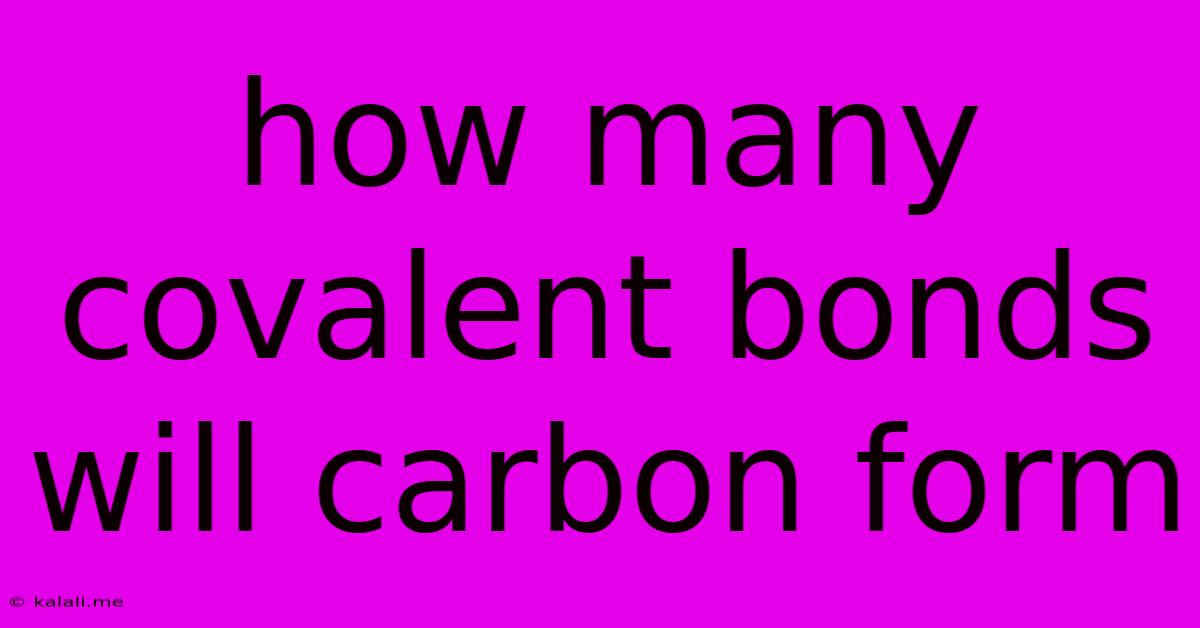How Many Covalent Bonds Will Carbon Form
Kalali
May 09, 2025 · 3 min read

Table of Contents
How Many Covalent Bonds Will Carbon Form? The Amazing Versatility of Carbon
Carbon, the backbone of life, is renowned for its incredible versatility. This versatility stems directly from its ability to form a specific number of covalent bonds, making it the perfect building block for an immense variety of molecules, from simple hydrocarbons to complex biomolecules like DNA. But just how many covalent bonds does carbon form? This article delves into the fascinating answer.
The short answer: Carbon typically forms four covalent bonds.
This seemingly simple answer underlies the astonishing complexity of organic chemistry. Let's explore why this is the case and the implications for the vast array of carbon-based compounds.
Understanding Covalent Bonding
Before we dive into carbon's bonding behavior, let's briefly review the concept of covalent bonding. Covalent bonds are formed when atoms share electrons to achieve a stable electron configuration, usually a full outer electron shell. Atoms will share electrons to reach the octet rule (eight electrons in the outer shell), which provides stability.
Carbon's Electron Configuration: The Key to its Bonding
Carbon has an atomic number of 6, meaning it possesses six electrons. Its electron configuration is 1s²2s²2p². This means it has two electrons in the first electron shell and four electrons in its outer (valence) shell. To achieve a stable octet, carbon needs to gain four more electrons. Instead of gaining electrons, it's energetically more favorable for carbon to share four electrons through covalent bonding.
Different Types of Covalent Bonds Carbon Can Form
Carbon's ability to form four covalent bonds allows it to create a diverse range of structures. These structures include:
- Single bonds: One pair of shared electrons (represented as a single line, e.g., C-C). Ethane (C₂H₆) is a prime example of a molecule with carbon-carbon single bonds.
- Double bonds: Two pairs of shared electrons (represented as a double line, e.g., C=C). Ethylene (C₂H₄) demonstrates carbon-carbon double bonds.
- Triple bonds: Three pairs of shared electrons (represented as a triple line, e.g., C≡C). Acetylene (C₂H₂) is an example of a molecule with carbon-carbon triple bonds.
Carbon can also form covalent bonds with many other elements, including hydrogen, oxygen, nitrogen, sulfur, and halogens, contributing to the immense variety of organic and inorganic molecules found in nature and synthesized in laboratories.
Exceptions to the Rule: Are there times when carbon doesn't form four bonds?
While four covalent bonds are the norm for carbon, there are some exceptions, albeit rare. These often involve unusual circumstances or highly reactive species:
- Carbon Radicals: These are highly reactive species with an unpaired electron, leaving carbon with only three bonds.
- Carbenes: These are neutral molecules containing a divalent carbon atom with two single bonds and a lone pair of electrons.
- Carbocations and Carbanions: These are charged species where carbon has three or five bonds, respectively.
The Significance of Carbon's Tetravalency
The fact that carbon forms four covalent bonds is crucial to the existence of life as we know it. Its ability to create long chains, branched structures, and ring systems allows for the formation of incredibly complex molecules with diverse functions. This underlies the vast field of organic chemistry and the countless applications in materials science, medicine, and numerous other fields.
In conclusion, while there are exceptions, carbon typically and overwhelmingly forms four covalent bonds, a characteristic that is fundamental to its role as the building block of life and a cornerstone of countless organic and inorganic compounds. Understanding this fundamental aspect of carbon's chemistry opens a door to comprehending the incredible diversity of the molecular world.
Latest Posts
Latest Posts
-
How Many Chambers Are In A Fish Heart
May 09, 2025
-
Using The Data In The Table Determine The Rate Constant
May 09, 2025
-
17 Is 25 Of What Number
May 09, 2025
-
What Is The Percentage Of 30 Out Of 50
May 09, 2025
-
Pythagorean Theorem And The Distance Formula
May 09, 2025
Related Post
Thank you for visiting our website which covers about How Many Covalent Bonds Will Carbon Form . We hope the information provided has been useful to you. Feel free to contact us if you have any questions or need further assistance. See you next time and don't miss to bookmark.